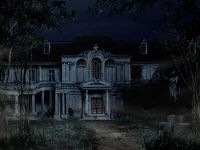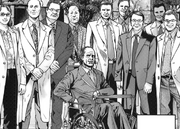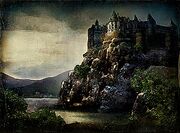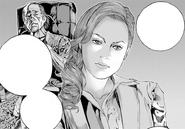(Capcom's primary storyline)
"I was to become a god! Creating a new world, with an advanced race of human beings...." — Spencer to Albert Wesker, shortly before his death. |
Dr. Oswell E. Spencer, Earl Spencer (オズウェル・E・スペンサー Ozuweru Ī Supensā) was a 20th-century British virologist and eugenicist. One of the founders of Umbrella Pharmaceuticals, Lord Spencer played a chief role in the development of the Umbrella Corporation, which dominated the pharmaceuticals and chemicals industry from the 1970s until its collapse in 2003.
A man of great wealth and power, Lord Spencer was also an aristocrat with a keen hobby in art collecting.[excerpt 1] He had a vision to remake the world and lead it into a new era, seeing the world's current state as self-destructive. He intended to use the research of Bio Organic Weapons to carry out his vision and mold a utopia for mankind with himself as its ruler.[1]
Biography
Early life

The Spencer coat of arms.
As a child, Spencer grew up in a prestigious family considered among the elite in European society for several generations,[2] and lived at their family castle somewhere in Europe.
Not much is known of his childhood, though he is known to have been a childhood fan of the 19th century encyclopedia, Natural History Conspectus.[3] Henry Travis' accounts of the Ndipaya described their folklore about kings who could live for centuries, granted great power after consuming a deadly flower.[4] Over the years his fascination with the account stayed with him, and shaped his eugenics ideals. Becoming close with Edward Ashford, the future 5th Earl Ashford, and the American James Marcus,[2] the three graduated as virologists. At least two others were also part of this tight-nit eugenics circle: Lord Beardsley, and Henry, a French count.
In the 1960s, Dr. Lord Ashford finally gave in to his curiosity about the Ndipaya. Their eugenics circle hypothesised that if the folklore was a true account, the flower would have had to be some form of retrovirus that would mutate the subject. The men began funding new laboratory constructions, in no small part by the Spencer Foundation, and Lord Spencer set out to West Africa with Dr. Marcus and his protege, Brandon Bailey, in 1966. Their exploration proved a success with the discovery of the ruined Ndipaya Kingdom's citadel, in the centre of which was the Garden of the Sun. In December, they confirmed they contained an RNA virus as hypothesised.[5]
President of Umbrella
Soon after their travelling to the United States, Spencer founded Umbrella Pharmaceuticals with Dr. Ashford and an indifferent Dr. Marcus. Believing the virus, dubbed Progenitor , to be the key to creating a superior race of men, the company was formed as a means of funding the project. Spencer, with the aid of an employee named Wesker, started a foundation to raise thirteen children to be the best and brightest humanity had to offer when ultimately infected with Progenitor to become his supermen. Virologists Albert and Alex Wesker were raised by this foundation, dubbed within the company as the "Wesker Project".

A mansion mimicking his family home lay above Spencer's Arklay Laboratory.
Soon after, all three founders began work on creating new strain of Progenitor that could be sold to national governments as biological weaponry, in a project later known as the "t-Virus Project", Marcus' name for his strain becoming the standard name for a collection of mutant strains. Spencer's research was conducted at the Arklay Laboratory , beneath an elaborate mansion he had commissioned in anticipation for this purpose in 1962. The architect, George Trevor , and his family were invited to the mansion to celebrate its completion in late 1967 as a pretext for their abduction and experimentation with Progenitor, Spencer wanting no one other than him to know the complex maze of puzzles designed to slow intruders.
Over the next few years Umbrella saw fierce competition between the three founders over control of the company, and the improvement of the fledgling t-Virus offered a means to gain that control due to its potential to create the bioweapon assets for the market. Ashford died in 1968 from exposure to the virus, and his son Alexander was not proficient in that field, thus effectively wiping out that family's influence. Bailey had been exiled to West Africa to oversee cultivation of the Sonnentreppe flowers. This left the fate of the company down to Spencer and Marcus, who had become mutually suspicious of the others' intent. Marcus had become a liability to the company over the years despite his isolation; he had run an executive training school for new Umbrella managers in the 1970s, but it was shut down in 1978 following his use of several students as test subjects for his virus, even shipping their bodies to Spencer's Arklay Laboratory for further research. In 1988, Spencer gave the order for Marcus' assassination, with the help of Arklay doctors Albert Wesker and William Birkin . As the sole remaining of the three founders, Spencer developed a new corporate narrative for his benefit, crediting the young Dr. Birkin with the creation of the t-Virus.

Spencer and his associates at Sonido Tortuga Island.
Research continued at Umbrella in the 1990s, with the creation of a new laboratory on Sonido de Tortuga Island, which he personally attended the opening of.[6] This lab was used by Dr. Alex Wesker for her own research. In 1991, Dr. Birkin was given praise for his research into a newly-discovered mutant virus dubbed "Golgotha", which could induce beneficial mutation to infected humans to make them superior. Intrigued by his research, a new laboratory was commissioned beneath Raccoon City's industrial district to specialise in G-Virus research. Spencer's decision proved to be somewhat controversial, with other researchers having derided its usefulness.
Raccoon City Destruction Incident
In May 1998 the Arklay Laboratory was sabotaged by one of Dr. Marcus' creations, Queen Leech. Its entire staff either killed or infected, and escaped B.O.W.s drew national attention in their killings of out-of-state hikers. As part of the X-Day contingency, Albert Wesker sent out two elite law enforcement teams to the laboratory to assist in his recovery of important B.O.W. research data before destroying the lab and killing them; Spencer's right-hand man Colonel Sergei Vladimir was also sent in personally for the task of recovering an experimental Tyrant and Umbrella's U.M.F.-013 supercomputer. While Vladimir was successful, Wesker chose to fake his death and hand the data over to a rival company, and several S.T.A.R.S. members escaped intent on beginning a police investigation.
In the immediate fallout, an executive named Morpheus D. Duvall was scapegoated for the containment failure, and later began a bioterror plot to steal viral samples in vengeance. Publicly, the so-called "mansion incident" did not harm Umbrella thanks to its influence over the local Raccoon City media, police and local government. However, a combination of this incident; Wesker's departure, and Spencer's refusal to allow promotion to his tight circle of executives led to Dr. Birkin dumping the t-Virus around Raccoon City to neutralise other Umbrella facilities in preparation for handing over the G-Virus to the US military, who were intent on starting their own bioweapons project and end support for Umbrella. An ambush by the Umbrella Security Services, an organization under Spencer's command, accidentally led to the t-Virus being released into the water supply through infected rats. Over the next week the city collapsed into anarchy as thousands of infected took part in cannibalistic murders.
Aware Raccoon City was doomed and the company no longer capable of lobbying against a Senate committee influenced by Derek C. Simmons, Spencer ordered Colonel Sergei Vladimir to recover the U.M.F.-013 from Raccoon City and take it to a safe location. On October 1, 1998, Spencer awoke to news of the US President's ordering of a bombing on the city. Soon after this, the US Congress voted in an act to liquidate Umbrella USA, and the actual corporation suffered a ban of business in the country. Expecting Umbrella to fail, Spencer assembled expert lawyers; fake witnesses, and bribes during the Raccoon Trials to divert all responsibility for deaths towards the US government. Unwilling to acknowledge their breaching of international law to obtain bioweaponry or even acknowledge B.O.W.s in general, the US government remained in a stalemate with Umbrella. This stalemate ended in early 2003, when Albert Wesker leaked excerpts of the recovered U.M.F.-013 data to the court. Umbrella was found liable for damages and was made bankrupt. An international arrest warrant was filed by both the United States and Russian Federation on Spencer, who quickly went into hiding.
Life as an outlaw
"When one buries a treasure, one should not leave behind a map..." — Excerpt from a journal entry regarding Spencer's plan to eliminate executives. |
"Alex has disappeared! I would be less concerned if that were the only regrettable report from the island.... And most importantly, all the research materials including the final virus that was to make me a god cannot be located! I have been betrayed!... I should have learned from my mistakes with Albert!" — Spencer's Memoirs 4 |

Spencer Estate, the spot that served as Oswell's hideout after the fall of Umbrella.
Intent on establishing a future successor to Umbrella, Spencer became obsessive in maintaining what little order he had left. Right after the Raccoon City bombing, he had already ordered a purge of the senior executive staff to prevent the United States from learning of Progenitor. For the next three years he remained in his European castle, seen only by his loyalist bodyguards and his butler, Patrick. Intent on surviving long enough to see the rebirth of his organization, Spencer ordered Alex Wesker to begin research into a mutagenic virus capable of restoring his youth.[7] However, Alex betrayed him and disappeared after the project's success, taking the results, her researchers, subordinates, and the virus itself to Sushestovanie Island in the Baltic Sea.
Death
"I was to become a god! Creating a new world with an advanced race of human beings. Now, my candle burns dimly. Ironic isn't it? For someone who has the right to be a god... to face his own mortality?" — Spencer's final words to Wesker |

Spencer tells Wesker of his origins.
By 2006, Spencer was close to death, spending most of his days sat in his study and lacking the strength to eat solid foods.[2] Sensing that his death was inevitable, Spencer had Patrick send for Albert Wesker through an associate. Patrick paid Ricardo Irving handsomely to guarantee that Wesker would know where to meet Spencer. Following this, Patrick was dismissed from his services.[8] In August 2006, Wesker entered the castle and brutally murdered Spencer's guards before heading into Spencer's private office.

Spencer's death.
In their meeting, Spencer detailed the information on the Wesker Project and Albert's intentional infection with a variation of the Progenitor Virus in 1998 to become one of his supermen. Wesker was disinterested in Spencer's vision of being a god over mankind with his race of supermen. While not expecting Spencer to be much competition to his own goals, Wesker nevertheless decided to tie Spencer up as a loose end. To that end, he brutally killed Spencer by knife-handing him through the chest. He proclaimed that Spencer was not capable of being a god and as such did not have the right to aspire to such a goal.
Appearance
Despite various references made to him in previous Resident Evil games, Spencer's only confirmed appearance was in Resident Evil 5. He was shown in a flashback to be an elderly man in his eighties. He had light blue eyes and completely white, curly hair. He wore a purple evening robe with purple slippers, though he may have just been settling into more comfortable attire for the night. He was shown in a portrait wearing more formal attire, albeit with an older-age sense in his fashion. He was slightly confined to a wheelchair, which he was connected to through wires, though he was able to stand up and face Wesker during the last moments of his life, at the same time disconnecting himself from his life support. The chair kept track of his heart rate. Spencer would break into racked coughing at random times while speaking, and also seemed to have breathing problems. Since he has never been seen before his incredibly old state, when Spencer's health problems began is currently unknown, other than it possibly being as early as the late 1990s.
Personality
Spencer was divorced from human morality, viewing things only in terms of power and believing that only the strongest and/or most intelligent deserved to exist. Spencer was also very treacherous, as evidenced by his callous orchestration of the deaths of Edward Ashford and James Marcus, two longtime friends and fellow Umbrella founders. He achieved the latter at the hands of Albert Wesker and William Birkin, the doctor's most trusted students at the time. It was this very command from the CEO that motivated Wesker to abandon Umbrella, believing that he would be just as expendable and not wishing to share the fate of Marcus.
It is heavily implied that these Darwinistic, Machiavellian, and psychopathic elements and views, among others, were ultimately emulated by Albert and Alex Wesker as a result, including ironically enough their later treachery towards him. He was narcissistic, believing that he was entitled to be the god of a new world, filling his estate with portraits of himself and showing pride and haughtiness to his dying breath. By the time of his death, Spencer had become nihilistic and more bitter and twisted than ever, perhaps even deliberately provoking Wesker into killing him.
Despite all of this, he got along well with his butler, Patrick. The same could be said of fellow Umbrella executives before he had them killed, as his quiet nature and calm demeanor left them with no suspicions of his treachery.
Further notes
| Please remember to only add notable quotations on the quotes page. |
- In the English localization of Resident Evil: The Umbrella Chronicles, Spencer is incorrectly referred to as "Oswald E. Spencer" in the game's credits by the voice of a news reporter.
- In Resident Evil: Dead Aim, the massive Umbrella cruiser, Spencer Rain, was named after the Umbrella CEO.
- Spencer makes a cameo in Ultimate Marvel vs. Capcom 3. In the Nemesis ending, he is shown speaking with Director Colcord, about an "improvement" made to Nemesis.
- Although his birth year was given as 1931 in the BIOHAZARD 5 kaitaishinsho guide,[9] this conflicts with some reports in the game itself as well as prior elements in the franchise, namely his friendship with James Marcus since their college years, as Resident Evil 0 implied the latter was born in 1918. The RE.Net Recollections timeline changed this to being 1923.
Gallery
Sources
- excerpts
- ↑ Excerpt from BIOHAZARD CODE: Veronica Kanzenban Kaitai Shinsho, page 222:
"「バイオ1」の舞台となった洋館の持ち主。
貴族仲間であるエドワード・アシュフォードらとともに始祖ウイルスを発見し、 その研究を擬装するため製薬会社アンブレラを設立した。
世界的な富豪で、 美術品収集を趣味とする。"
- references
- ↑ Resident Evil 5 (2009), file: "Albert Wesker".
- ↑ 2.0 2.1 2.2 Resident Evil 5: Gold Edition (2010), file: "Patrick's Memoirs 1".
- ↑ Resident Evil 5 (2009), file: "Tricell".
- ↑ Resident Evil 5 (2009), file: "Ndipaya Tribe".
- ↑ Resident Evil 5 (2009), file: "From Chief Researcher Brandon's Journal - No. 1".
- ↑ BIOHAZARD heavenly island, "Episode 8: Tatakai".
- ↑ Resident Evil 5: Gold Edition (2010), file: "Spencer's Memoirs 1".
- ↑ Resident Evil 5: Gold Edition (2010), file: "Patrick's Memoirs 3".
- ↑ Resident Evil 5 guidebook
| |||||||||||||||||||||||||||||||||||||||||||||||||||||||||||||||||||||||||||||||||||||||||||||||||||||||||||||||||||||||||||||||||||||||||||||||||||||||||||||||||||||||||||||||||||











